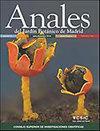Revisión del género monotípico Llavea (Cryptogrammoideae: Pteridaceae)
IF 0.7
4区 生物学
Q4 PLANT SCIENCES
引用次数: 1
Abstract
Llavea Lag. is a genus of Cryptogrammoideae (Pteridaceae), whose only species is distributed from southern United States and Mexico to Guatemala and Costa Rica, although it lives mainly in Mesoamerica, inhabiting preferably calcicolous habitats associated with forests and mountains. The genus is easily recognized by the presence of fertile leaves hemi-dimorphic, with the fertile apical portion with longer and narrower segments than the sterile ones, with strongly revolute margin, and rhizome scales bicolorous, shiny, and black. This paper presents a revision of the genus, nomenclatural issues are resolved, and and palynological morphological diversity are reviewed, as well as its distribution, phenology, ecology, and applications, based on field and herbarium specimens studies. In addition, two names related to Llavea, Allosorus karwinskii Kunze and Ceratodactylis osmundioides J. Sm., were lectotypified.Llavea单型属(隐grammoideae: Pteridaceae)综述
Llavea滞后。是隐苔科(蕨类科)的一个属,其唯一的种类分布于美国南部和墨西哥到危地马拉和哥斯达黎加,尽管它主要生活在中美洲,最好居住在与森林和山脉有关的钙质栖息地。可育叶半二形,可育的顶端部分比不育的长而窄,边缘强烈旋转,根茎鳞片双色,有光泽,黑色,很容易识别。本文在野外和植物标本室标本研究的基础上,对孢粉属进行了修订,解决了命名问题,并对孢粉的形态多样性及其分布、物候、生态学和应用进行了综述。此外,还发现了与lavea有关的Allosorus karwinskii Kunze和Ceratodactylis osmundiides J. Sm。,被选型。
本文章由计算机程序翻译,如有差异,请以英文原文为准。
求助全文
约1分钟内获得全文
求助全文
来源期刊

Anales Del Jardin Botanico De Madrid
PLANT SCIENCES-
CiteScore
1.20
自引率
0.00%
发文量
9
审稿时长
>12 weeks
期刊介绍:
Anales del Jardín Botánico de Madrid features original and unpublished articles in fields such as taxonomy and systematics of all plant groups and fungi, including related fields like biogeography, bioinformatics, conservation, ecophysiology, phylogeny, phylogeography, functional morphology, nomenclature and plant-animal relations, as well as reviews and summary works. Anales del Jardín Botánico de Madrid is published half-yearly, with two issues appearing in June and December.
 求助内容:
求助内容: 应助结果提醒方式:
应助结果提醒方式:


